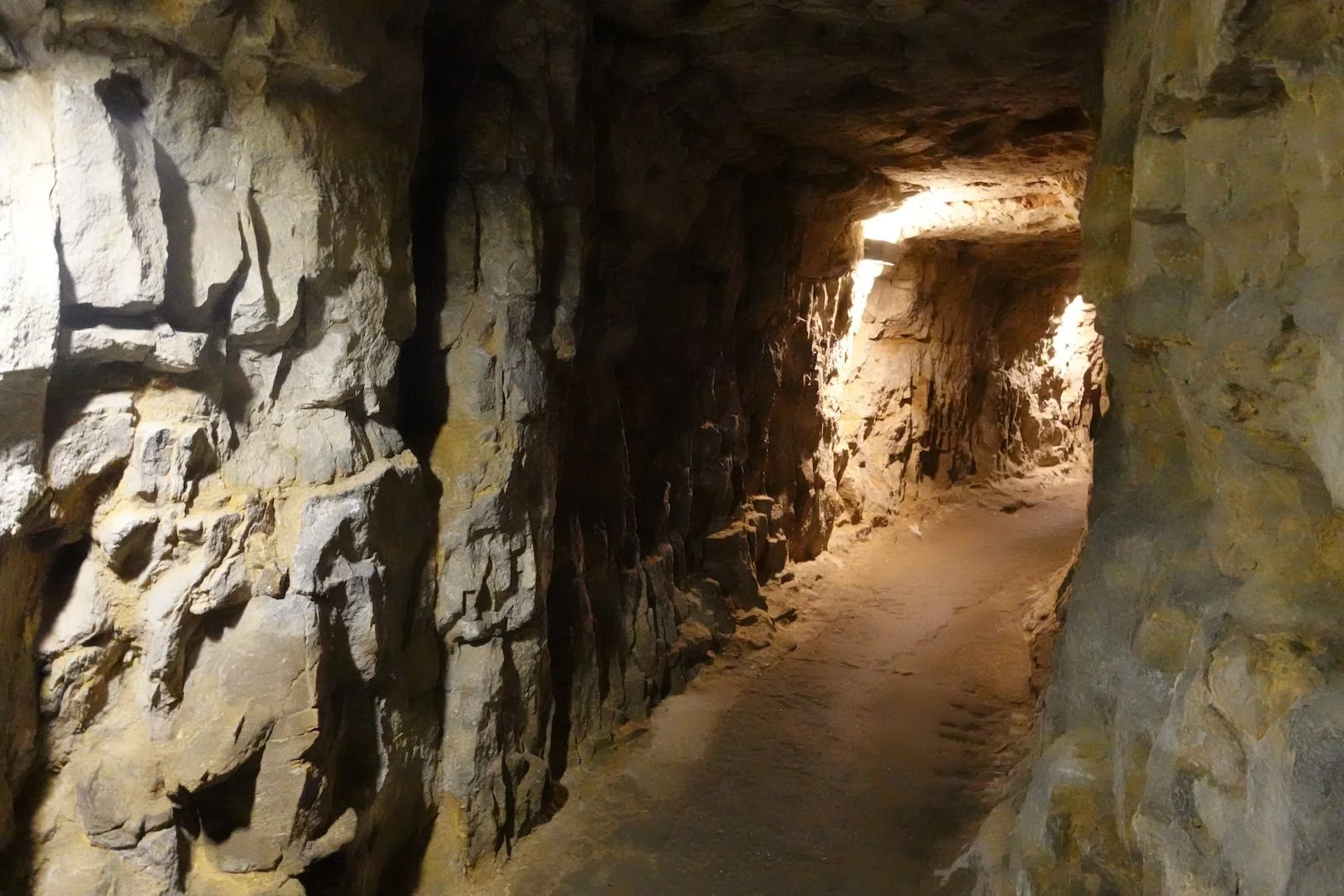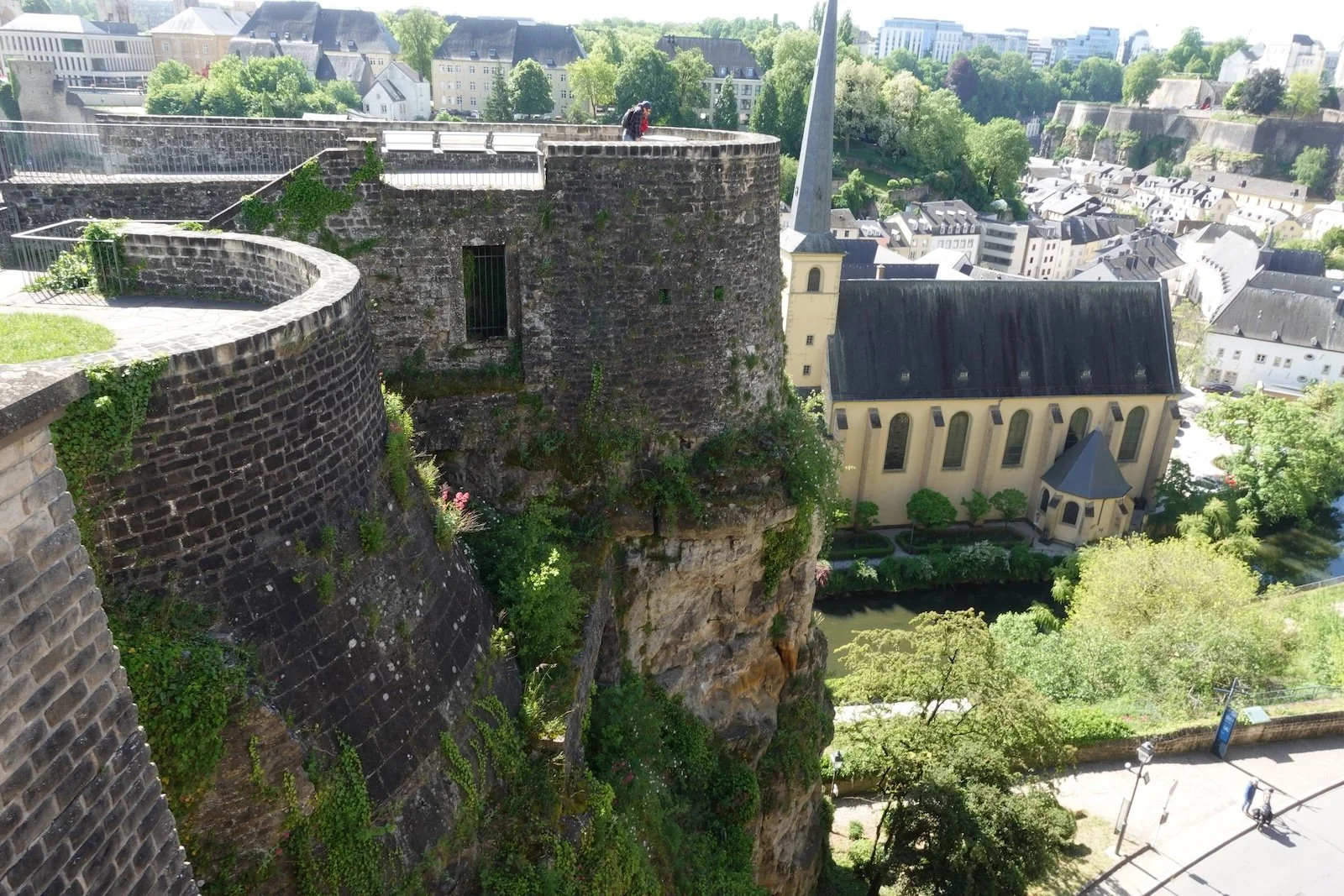Exploring the fascinating Casemates Du Bock underground caverns in Luxembourg City

© Images by Hiatus.Design
The Casemates du Bock are an extraordinary network of underground tunnels and chambers carved into the rocky cliffs of Luxembourg City. They are a testament to the city's strategic importance and architectural ingenuity over centuries.
The origins of the Casemates du Bock date back to 963 AD when Count Siegfried acquired the Bock promontory and built the Castle of Lucilinburhuc, laying the foundation for Luxembourg City. In 1644, under Spanish rule, the initial casemates were constructed as part of the city's fortifications. These tunnels were expanded in the 18th century by the Austrians, notably by General Neipperg in 1744, to include a central passage 110 metres long and up to 7 metres wide, with 25 cannon slots and a 47-metre-deep well supplying fresh water.
The Casemates du Bock played a crucial role in the city's defence, especially during the seven-month siege by French Revolutionary forces in 1794. Despite the prolonged assault, the fortress walls remained unbreached, earning Luxembourg the nickname "Gibraltar of the North." The casemates allowed for protected movement of troops and storage of supplies, making them an integral part of the city's military strategy.
Following the 1867 Treaty of London, which aimed to neutralize Luxembourg, the fortress was ordered to be dismantled. However, due to the casemates' integration into the city's structure, complete demolition was impossible without damaging the city itself. As a result, 17 kilometres of the underground network were preserved.
During World War II, the Casemates du Bock served as bomb shelters, providing refuge for up to 35,000 people during air raids. This adaptation from military fortification to civilian shelter underscores their versatility and importance in Luxembourg's history.
In recognition of their historical and architectural significance, the Casemates du Bock, along with other parts of Luxembourg's old quarters and fortifications, were designated a UNESCO World Heritage Site in 1994. Today, they are a major tourist attraction, offering visitors a glimpse into the city's storied past.
You might also like:
Showcasing the extraordinary skill, balance, and focus required in the sport, Red Bull Slack Warrior 2025 competition took place on 9th August at Noblessner Harbour in Tallinn, Estonia, marking the third edition of this high-energy slacklining event in the country.
Lake Bled, nestled in the Julian Alps of north western Slovenia, is one of the country’s most iconic and picturesque destinations, drawing visitors from across the world for its fairy-tale scenery and tranquil atmosphere.
Dramatically perched above the narrow gorge that leads into the valley from Piedmont, the Fort di Bard is a striking 19th-century fortress nestled in the Aosta Valley of northern Italy, that was used as a the main set for Marvel’s Avengers: Age of Ultron
On 24 July 2025, Tallinn hosted one of its biggest ever concerts when rock legends AC/DC brought their Power Up tour to the Song Festival Grounds. It was the band’s first time performing in Estonia and anticipation had been building for months, with tickets selling out well in advance.
Testament to the Luxembourg city's strategic importance and architectural ingenuity over centuries, the Casemates du Bock are an extraordinary network of underground tunnels and chambers carved into the rocky cliffs.
Tucked away in northern Tallinn near the Viimsi peninsula, the Rohuneeme rocket base, is one of Estonia’s most intriguing yet lesser-known Cold War relics.
See Prague at its most magical, glide past Charles Bridge, Prague Castle, and more on this golden hour boat tour of the Vltava. History, romance, and river views in under an hour.
Renowned for its intricate Gothic architecture and rich history, the Duomo di Milano, or Milan Cathedral, stands as an iconic symbol of Milan, Italy.
Les Tres Xemeneies (The Three Chimneys) is one of Barcelona’s most distinctive industrial landmarks, which we can’t help but think resemble Bender from Futurama!
Standing in the heart of Andorra la Vella, Salvador Dalí’s Noblesse du Temps (The Nobility of Time) is an iconic bronze sculpture that embodies his fascination with time, dreams, and the surreal nature of existence.
Widely regarded as the birthplace of Western theatre, the Theatre of Dionysus Eleuthereus, located on the southern slope of the Acropolis in Athens, Greece, is one of the most significant cultural landmarks of the ancient world.
Initially established as a study collection for the arts and crafts school, the Design Museum in Helsinki is one of the world’s oldest museums dedicated to design, tracing its origins back to 1873.
Built in the 17th century during the reign of King Christian IV, the Round Tower, or Rundetaarn in Danish, is one of Copenhagen’s most iconic landmarks and a testament to the city’s rich history and architectural ingenuity.
Housed in a historic power station building originally constructed in 1913, the Energy Discovery Centre in Tallinn, Estonia, is an engaging science and technology museum dedicated to exploring the fascinating world of energy, electricity, and physics.
Located in the historic Clementinum complex, the Baroque Library Hall in the Clementinum in Prague is one of the most stunning examples of Baroque architecture and artistry in Europe
Facing the Russian fortress of Ivangorod across the river, Narva Castle, also known as Hermann Castle, stands on the banks of the Narva River in Estonia, marking the easternmost boundary of the European Union.
This immersive ‘Colour of Life’ exhibition at the Royal Łazienki Museum in central Warsaw, offered an intimate glimpse into the life and art of one of the 20th century’s most iconic artists, Frida Kahlo.
Opened in 1989, the Planetarium in Copenhagen is an incredible destination for astronomy and space enthusiasts.
Attending the Robotex International Robotics Festival, held at Tallinn’s Unibet Arena, this year was a fun experience, packed with groundbreaking technology, cool competitions and inspiring ideas!
When we visited the Amox Rex museum, the main exhibition was from Larissa Sansour, a prominent Palestinian-Danish artist whose multidisciplinary work explores themes of identity, memory, and the intersection of politics and culture.
Patarei Prison (‘The Battery’ in English), located in Tallinn, Estonia, is a chilling and historically significant site that reflects the nation’s turbulent history, that we had a chance to tour in winter 2024.
From November 19 to 21, 2024, the Messe Bremen in Germany hosted the SpaceTech Expo Europe, the continent’s largest trade fair dedicated to space technology.
Located in the heart of the city, the MO Museum in Vilnius is a prominent cultural landmark dedicated to modern and contemporary art that’s definitely worth visiting if you’re in the city!
The Belvedere Palace and Gardens in Vienna are a stunning example of Baroque architecture and landscape design, and they play a significant role in the city’s cultural and historical heritage. The complex consists of two magnificent palaces—Upper Belvedere and Lower Belvedere—connected by a vast, meticulously designed garden.
After hearing about a ghostly relic from the last century, we decided to travel to the furthest reaches of Europe to visit a decaying but fascinating former factory located on an island next to the Russian border.
Prague Castle stands as the centrepiece of Prague’s skyline, a majestic complex that embodies centuries of Czech history and architectural splendour.
Often compared to Montmartre in Paris or Freetown Christiania in Copenhagen, Užupis is known for its bohemian spirit, artistic community, and independent character. The district is situated just across the Vilnia River, which separates it from the historic Old Town of Vilnius, making it both central and slightly secluded.
The Universum, located in Bremen, Germany, is a highly interactive science museum that combines learning with highly interactive entertainment – a combination we loved!
Known for its striking architectural design—resembling a metallic whale or a futuristic clam shell (see below)—it captivated us before we even stepped inside.
Shepard Fairey's Photo Synthesis exhibition at Fotografiska Tallinn is a wonderful, intricate and impactful exploration of his artistic journey, running until March 2025.
Despite not featuring a single Banksy original, we were excited to visit an unauthorised Banksy exhibition that’s been touring around Europe since 2021.
About the Author:
Chris is the founder of Hiatus.Design, a mission-driven branding and website design company that works with clients all over the world.
Over the course of his life, he has travelled to more than 60 countries across six continents, earned two Guinness World Records, completed the legendary Marathon des Sables, summited Mont Blanc and unclimbed peaks in Asia, become a Fellow of the Royal Geographical Society (FRGS), rowed across the Atlantic Ocean and obtained a Masterʼs degree in Business Management (MA).
































